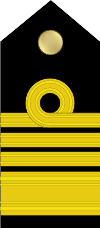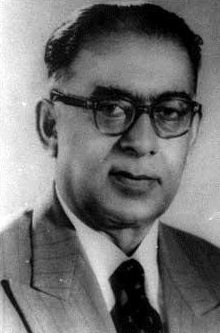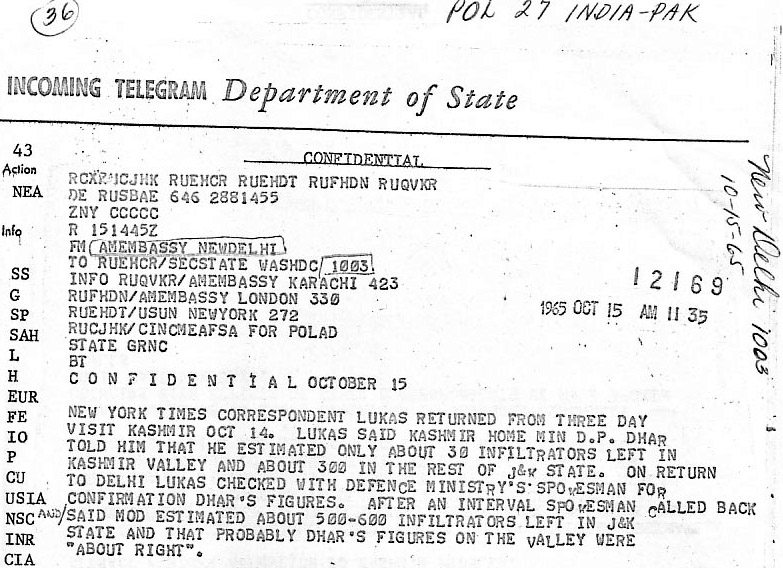|
Adhar Kumar Chatterji
Admiral Adhar Kumar Chatterji (4 March 1914 – 6 August 2001) was an Admiral in the Indian Navy. He served as the 6th Chief of the Naval Staff, from 4 March 1966, until 28 February 1970. He was the first Indian officer of the navy to hold the rank of full Admiral. He is credited with the transformation of the Indian Navy. He made sweeping changes and restructured the navy, creating the Western and Eastern Naval Commands and the Western Fleet. Under him, the Indian Navy also entered the submarine age, with the commissioning of in 1967. Early life Chatterji was born in Dacca on 22 November 1914. He attended the Presidency College (as a graduating student of the University of Calcutta), graduating in 1933. The same year he saw a notice at the college about the relaxation of entry criteria for the Royal Indian Marine. He applied for and topped the Federal Public Service examination. Naval career Early career Chatterji was one of the first Indian cadet-entry officers to joi ... [...More Info...] [...Related Items...] OR: [Wikipedia] [Google] [Baidu] |
Admiral (India)
Admiral is a four-star naval flag officer rank in the Indian Navy. It is the highest active rank in the Indian Navy. Admiral ranks above the three-star rank of vice admiral and below the five-star rank of admiral of the fleet, which has never been awarded or held. An admiral may be referred to as a full admiral or four-star admiral to distinguish them from lower flag officer ranks like vice admiral and rear admiral. The rank is held by the Chief of the Naval Staff (CNS), the professional head of the Indian Navy, since 1968. The rank may also be held by the Chief of Defence Staff (CDS) if the holder is a serving Indian Navy flag officer. Admiral Adhar Kumar Chatterji was the first Indian officer to hold the rank of full admiral. The current Chief of the Naval Staff (CNS) and only full admiral in the Indian Armed Forces is Admiral R. Hari Kumar. The equivalent rank in the Indian Army is general and in the Indian Air Force is air chief marshal. Insignia The flag o ... [...More Info...] [...Related Items...] OR: [Wikipedia] [Google] [Baidu] |
Bhaskar Sadashiv Soman
Admiral Bhaskar Sadashiv Soman (30 March 1913 – 8 February 1995) was an Indian Navy Admiral. He was in command of the Indian Navy from 1962 to 1966 as the 5th Chief of the Naval Staff (CNS). Early life Soman was born in Gwalior, the capital of the eponymous princely state. He received his early education at the Indian National Congress' Tilak Vidyalaya and at a school in Sangli State. Career He subsequently entered the Royal Indian Marine (RIM), and following initial training on the training ship ''T/S Dufferin'', was selected for officer training in the United Kingdom in 1932. He was appointed a sub-lieutenant in the RIM on 1 September 1934, and was promoted to lieutenant on 1 September 1937. During World War II, Soman was promoted to acting lieutenant-commander on 29 April 1944, and to the permanent rank of lieutenant-commander on 1 September 1945. During the war, he served in various shore establishments and in the service's Landing Craft Wing. Soman was promoted to the ... [...More Info...] [...Related Items...] OR: [Wikipedia] [Google] [Baidu] |
Eastern Naval Command
The Eastern Naval Command is one of the three command-level formations of the Indian Navy. It is headquartered in Visakhapatnam, Andhra Pradesh. The command is responsible for the all naval forces in the Bay of Bengal and parts of the Indian Ocean and the naval establishments on the east coast of India. The Command was established on 1 March 1968. The Command is commanded by a Three-star rank, Three Star Flag Officer of the rank of Vice Admiral with the title Flag Officer Commanding-in-Chief Eastern Command (FOC-in-C). Vice Admiral Biswajit Dasgupta is the current FOC-in-C ENC, who took over on 30 November 2021. History After the independence of India, independence and the partition of India on 15 August 1947, the ships and personnel of the Royal Indian Navy were divided between the Dominion of India and the Dominion of Pakistan. The division of the ships was on the basis of two-thirds of the fleet to India, one third to Pakistan. The Surface Fleet of the Navy was called Indian ... [...More Info...] [...Related Items...] OR: [Wikipedia] [Google] [Baidu] |
Western Naval Command
The Western Naval Command is one of the three command–level formations of the Indian Navy. It is headquartered in Mumbai, Maharashtra. As the senior–most of the three formations, the command is responsible for the all naval forces in the Arabian Sea and western parts of the Indian Ocean and the naval establishments on the west coast of India. The Command was formed on 1 March 1968. The Command is commanded by a Three Star Flag Officer of the rank of Vice Admiral with the title Flag Officer Commanding-in-Chief Western Command (FOC-in-C). Vice Admiral Ajendra Bahadur Singh is the current FOC-in-C WNC, who took over on 30 November 2021. History After the independence and the partition of India on 15 August 1947, the ships and personnel of the Royal Indian Navy were divided between the Dominion of India and the Dominion of Pakistan. The division of the ships was on the basis of two-thirds of the fleet to India, one third to Pakistan. Two new appointments were created, the R ... [...More Info...] [...Related Items...] OR: [Wikipedia] [Google] [Baidu] |
Admiral
Admiral is one of the highest ranks in some navies. In the Commonwealth nations and the United States, a "full" admiral is equivalent to a "full" general in the army or the air force, and is above vice admiral and below admiral of the fleet, or fleet admiral. Etymology The word in Middle English comes from Anglo-French , "commander", from Medieval Latin , . These evolved from the Arabic () – (), “king, prince, chief, leader, nobleman, lord, a governor, commander, or person who rules over a number of people,” and (), the Arabic article answering to “the.” In Arabic, admiral is also represented as (), where () means the sea. The 1818 edition of Samuel Johnson's ''A Dictionary of the English Language'', edited and revised by the Rev. Henry John Todd, states that the term “has been traced to the Arab. emir or amir, lord or commander, and the Gr. , the sea, q. d. ''prince of the sea''. The word is written both with and without the d, in other languages, as w ... [...More Info...] [...Related Items...] OR: [Wikipedia] [Google] [Baidu] |
Indian Navy
The Indian Navy is the maritime branch of the Indian Armed Forces. The President of India is the Supreme Commander of the Indian Navy. The Chief of Naval Staff, a four-star admiral, commands the navy. As a blue-water navy, it operates significantly in the Persian Gulf Region, the Horn of Africa, the Strait of Malacca, and routinely conducts anti-piracy operations and partners with other navies in the region. It also conducts routine two to three month-long deployments in the South and East China seas as well as the western Mediterranean sea simultaneously. The primary objective of the navy is to safeguard the nation's maritime borders, and in conjunction with other Armed Forces of the union, act to deter or defeat any threats or aggression against the territory, people or maritime interests of India, both in war and peace. Through joint exercises, goodwill visits and humanitarian missions, including disaster relief, the Indian Navy promotes bilateral relations between ... [...More Info...] [...Related Items...] OR: [Wikipedia] [Google] [Baidu] |
List Of High Commissioners Of India To The United Kingdom
The High Commissioner of India to the United Kingdom is the head of the High Commission of India to the United Kingdom. The High Commission is located at India House in London. History In 1919, a committee chaired by the Marquess of Crewe determined there existed the need to separate the agency work of the India Office from its other political and administrative roles, and recommended the transfer of all such work to "a High Commissioner for India or some similar Indian Governmental Representative in London." It was also felt popular opinion in India would view this as a step towards full Dominion status for India. The Government of India Act that same year upheld the recommendations of the committee, making provision for "the appointment of a High Commissioner by His Majesty by Order in Council, which might delegate to the official any of the contractual powers of the Secretary of State or Indiain Council, and prescribe the conditions under which he should act on behalf of t ... [...More Info...] [...Related Items...] OR: [Wikipedia] [Google] [Baidu] |
Indo-Pakistani War Of 1965
The Indo-Pakistani War of 1965 or the Second Kashmir War was a culmination of skirmishes that took place between April 1965 and September 1965 between Pakistan and India. The conflict began following Pakistan's Operation Gibraltar, which was designed to infiltrate forces into Jammu and Kashmir to precipitate an insurgency against Indian rule, It became the immediate cause of the war. The seventeen-day war caused thousands of casualties on both sides and witnessed the largest engagement of armored vehicles and the largest tank battle since World War II. Hostilities between the two countries ended after a ceasefire was declared through UNSC Resolution 211 following a diplomatic intervention by the Soviet Union and the United States, and the subsequent issuance of the Tashkent Declaration. Much of the war was fought by the countries' land forces in Kashmir and along the border between India and Pakistan. This war saw the largest amassing of troops in Kashmir since the Partition o ... [...More Info...] [...Related Items...] OR: [Wikipedia] [Google] [Baidu] |
Liberation Of Goa
The Annexation of Goa was the process in which the Republic of India annexed ', the then Portuguese Indian territories of Goa, Daman and Diu, starting with the armed action carried out by the Indian Armed Forces in December 1961. In India, this action is referred to as the "Liberation of Goa". In Portugal, it is referred to as the "Invasion of Goa". Jawaharlal Nehru had hoped that the popular movement in Goa and the pressure of world public opinion would force the Portuguese Goan authorities to grant it independence but since it did not have any effect, he decided to take it by force. The "armed action" was code named Operation Vijay (meaning "Victory" in Sanskrit) by the Indian Armed Forces. It involved air, sea and land strikes for over 36 hours, and was a decisive victory for India, ending 451 years of rule by Portugal over its remaining exclaves in India. The engagement lasted two days, and twenty-two Indians and thirty Portuguese were killed in the fighting. The brief ... [...More Info...] [...Related Items...] OR: [Wikipedia] [Google] [Baidu] |
World War II
World War II or the Second World War, often abbreviated as WWII or WW2, was a world war that lasted from 1939 to 1945. It involved the vast majority of the world's countries—including all of the great powers—forming two opposing military alliances: the Allies and the Axis powers. World War II was a total war that directly involved more than 100 million personnel from more than 30 countries. The major participants in the war threw their entire economic, industrial, and scientific capabilities behind the war effort, blurring the distinction between civilian and military resources. Aircraft played a major role in the conflict, enabling the strategic bombing of population centres and deploying the only two nuclear weapons ever used in war. World War II was by far the deadliest conflict in human history; it resulted in 70 to 85 million fatalities, mostly among civilians. Tens of millions died due to genocides (including the Holocaust), starvation, massa ... [...More Info...] [...Related Items...] OR: [Wikipedia] [Google] [Baidu] |
HMIS Kathiawar (J155)
HMIS ''Kathiawar'' (J155) was a built for the Royal Navy, but transferred to the Royal Indian Navy (RIN) during the Second World War. Design and description The ''Bangor'' class was designed as a small minesweeper that could be easily built in large numbers by civilian shipyards; as steam turbines were difficult to manufacture, the ships were designed to accept a wide variety of engines. ''Kathiawar'' displaced at standard load and at deep load. The ship had an overall length of , a beam of and a draught of .Lenton, pp. 253–54 The ship's complement consisted of 60 officers and ratings.Chesneau, p. 64 She was powered by two Parsons geared steam turbines, each driving one shaft, using steam provided by two Admiralty three-drum boilers. The engines produced a total of and gave a maximum speed of . ''Kathiawar'' carried a maximum of of fuel oil that gave her a range of at .Lenton, p. 254 The turbine-powered ''Bangor''s were armed with a 12-pounder anti-aircraft gu ... [...More Info...] [...Related Items...] OR: [Wikipedia] [Google] [Baidu] |
Western Fleet (India)
The Western Fleet is a Naval fleet of the Indian Navy. It is known as the 'Sword Arm' of the Indian Navy. It is headquartered at Mumbai, Maharashtra on the west coast of India. It is a part of the Western Naval Command and is responsible for the naval forces in the Arabian Sea and parts of the Indian Ocean. The Western Fleet was formally constituted on 1 March 1968. The Fleet is commanded by a Two Star Flag Officer of the rank of Rear Admiral with the title Flag Officer Commanding Western Fleet (FOCWF). Rear Admiral Vineet McCarty is the current FOCWF, who took over on 15 November 2022. The current flagship of the Western Fleet is the aircraft carrier . History After the independence and the partition of India on 15 August 1947, the ships and personnel of the Royal Indian Navy were divided between the Dominion of India and the Dominion of Pakistan. The division of the ships was on the basis of two-thirds of the fleet to India, one third to Pakistan. This was then called the ... [...More Info...] [...Related Items...] OR: [Wikipedia] [Google] [Baidu] |


_with_a_Sea_Harrier.jpg)



